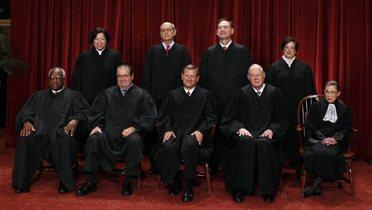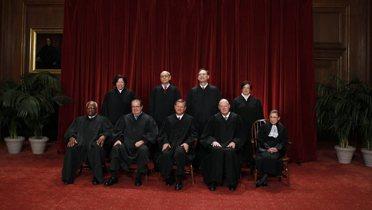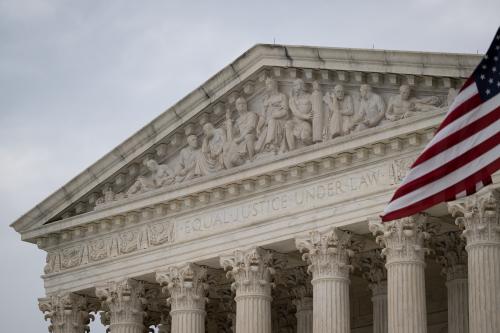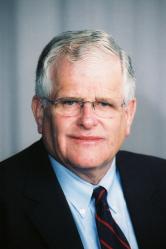In an interview last October, candidate Joe Biden—pressed on whether he favored expanding the Supreme Court—repeated his skepticism but promised to name a bipartisan commission to study “a number of other things that our constitutional scholars have debated.” Progressive groups will continue to press adding justices to offset Trump appointees who were confirmed with what many called a double standard. Whatever the commission recommends, the record of previous commissions suggests that even fallback recommendations won’t go far—long-brewing topics such as judicial term limits, electronic coverage of court proceedings, and tightened ethics rules. Long-delayed lower court expansion is already on the legislative agenda, although some Republicans are asking why House Democrats waited until the Biden presidency to move that ball.
The commission is still forming, but such an exercise is not new. There have been several court commissions over the past 50 years. Below is some background on them, including one proposed by then-Senate Judiciary Committee chairman Biden.
Court commissions are nothing new
Biden’s 2021 commission will join eight major court commissions in just the last half-century—ad hoc government bodies charged with finding causes or at least remedies for perceived federal court problems. (This list excludes non-government groups except the Brookings task force because of its ties to Biden.)
| Created | Popular Name | Topic | Origin | Members |
| 1971 | Freund Committee | Restructuring | Judiciary | 7 |
| 1972 | Hruska Commission | Restructuring | Congress | 18 |
| 1976 | Bork Committee | General | Executive branch | 10 |
| 1988 | Federal Courts Study Committee | General | Congress | 15 |
| 1988 | Brookings Civil Justice Task Force | Case management | Other | 35 |
| 1990 | Kastenmeier Commission | Ethics | Congress | 14 |
| 1997 | White Commission | Restructuring | Congress | 5 |
| 2004 | Breyer Committee | Ethics | Judiciary | 6 |
Court change is difficult and tends toward incrementalism
Paul Light’s study of investigations of executive branch breakdowns shows that commissions can have big impacts. In contrast, federal court commissions, despite frequent crisis-laden rhetoric, have produced important but decidedly modest housekeeping adjustments—some might call them “petty tinkering,” to use Roscoe Pound’s phrase.
Federal court change—commission-motivated or otherwise—has largely been incremental. Support is typically diffuse and opposition well-organized. Interest groups argue that whatever problems exist are tolerable and change is risky. Even big changes—the 1891 creation of the courts of appeals and the 1939 statute vesting judges with third branch administration—had long gestation periods of legislative-judicial interaction and a consensus that action was needed.
Biden isn’t new to court commissions
At then-Chairman Biden’s 1988 suggestion, the Brookings Institution—amid concerns about “high litigation costs and delay that burden both plaintiffs and defendants, average citizens and large corporations”—created its Civil Justice Reform Task Force comprising mainly plaintiff and defense litigators and former judges.[1] Biden then introduced the Civil Justice Reform Act, which mandated local cost-and-delay-reduction planning and national assessments and raised the ire of some federal judges. Officially, the judicial branch, endorsed the bill’s goals but said that “the mandatory nature and rigidity of some of the provisions [in an earlier version] would impair judges’ ability to manage their dockets most effectively and might intrude on procedural matters that are properly the province of the Judiciary.” As enacted, the statute imposed no case management requirements.
Congress enacted the statute as part of the 1990 Judicial Improvements Act. Federal case management, although hardly uniform, is more aggressive than it was 30 years ago; but that is due more to federal courts’ long-standing commitment to effective case management than to the Biden statute’s since-lapsed planning apparatus. Nevertheless, the statute made a lasting contribution by directing the semi-annual publication (by name) of district, magistrate, and bankruptcy judges’ backlogs. Informal conversations and docket analyses indicate that judges clear old cases to avoid inclusion in what some judges still call the “Biden reports”.
Another title of the 1990 Act implemented a raft of recommendations of the statutory, three-branch Federal Courts Study Committee—created in 1988 largely at the urging of federal judges—to develop a “long-range plan for the federal judiciary.” That title made some jurisdictional refinements, for example, and clarified the status of Federal Claims Court judges.
But, despite the committee’s assertion of a federal court “crisis”, the Act only nibbled at its more substantial proposals, such as largely eliminating federal “diversity jurisdiction” (which allows state law disputes to be filed in federal court if the parties are citizens of different states); eliminating such jurisdiction is a recurring idea long opposed by federal practitioners and some federal judges. The committee suggested structural changes to ease “the appellate caseload crisis,” but the Act simply directed another Federal Judicial Center study.
Other titles created 78 new judgeships (the most recent significant increase), tweaked the judicial discipline statute, and created the judicial ethics commission discussed below.
Other commissions: court restructuring and judicial ethics
Court restructuring
The Federal Judicial Center’s Study Group on the Caseload of the Supreme Court—seven lawyers and law professors chaired by Harvard’s Paul Freund—was part of Chief Justice Warren Burger’s efforts to reduce the Court’s workload. Claiming the absence of “conditions essential for the performance of the Court’s mission,” its 1972 report proposed inserting a new appellate tribunal above the existing courts of appeals. Opponents, including several justices, killed the proposal, arguing the new court would wall off civil rights cases from Supreme Court review; circuit judges feared another appellate tier would diminish their status. The decline in the Court’s plenary docket—from the 150-case range in the 1970s to half that today—has rendered the workload claim moot (while exacerbating concern over unresolved ambiguities in federal law).
Next, a 1972 statute created the three-branch Commission on Revision of the Federal Court Appellate System—mainly legislators and judges, chaired by Senator Roman Hruska (R-Neb.). Its mandate: assess the appellate courts’ “structure [, and] internal procedures” and their “geographic boundaries” as defined by their judicial circuits.
The Revision Commission’s 1975 report, on structure and internal procedures, proposed another intermediate appellate tribunal, which met the same fate as the Study Group’s. A 1978 statute (at section 6) however, allowed large courts some flexibility in those rare cases that would otherwise require a decision by all members of the appeals court. A 1982 statute rationalized the designation of appellate and district court chief judges, ending a seniority system that produced chief judges-for-life in some courts and short-term chief judges in others. Both were born from Revision Commission recommendations.
The commission’s earlier 1973 report acknowledged that circuit boundaries were “historical accident[s]” and failed such criteria as parity of appellate caseloads, but it eschewed a general realignment because the status quo had its constituents’ “respect and loyalty.” It did recommend splitting the Ninth circuit (Pacific Coast and adjoining states) and thus its 13-judgeship court of appeals and the Fifth circuit (Florida to Texas) and its 15-judgeship court. Eight years later, Congress divided the old Fifth circuit into smaller Fifth and new Eleventh circuits, once the old Fifth’s circuit judges concluded that their court—by then 26 judgeships— couldn’t function effectively, and civil rights legislators relaxed their opposition.
Division-averse Ninth circuit judges and lawyers have defeated all division proposals, including a 1998 recommendation of the statutory Commission on Structural Alternatives for the Federal Courts of Appeals, a small, chief-justice-appointed commission created after legislative stalemate and chaired by retired Justice Byron White. Its proposal to restructure the by-then 28-judgeship court but not divide its geographic circuit was dead on arrival (although every Congress sees Republican-sponsored bills to divide the Ninth circuit).
Judicial ethics commissions
Other than rare impeachment and removal, federal judicial conduct is subject to the Judicial Conference’s advisory code of conduct and the remote possibility of judge-imposed sanctions under the 1980 Judicial Conduct and Disability Act (Supreme Court justices excepted)—a product of legislative reaction to instances of misconduct and lengthy negotiations with suspicious federal judges.
The statute got a new look when the 1990 Improvements Act created a National Judicial Discipline and Removal Commission—legislators, judges, academics—chaired by former Wisconsin Representative Robert Kastenmeier. Its 1993 report proposed over 20 changes to the 1980 Act and the judiciary’s administration of it. Housekeeping legislation enacted some recommendations and the Judicial Conference included others in its revision of then-advisory rules for administering the Act. Other recommendations were non-starters, such as courts’ using nonjudges to help investigate complaints, or Supreme Court consideration of “policies and procedures for filing and disposition of [misconduct] complaints” against” justices.
Then, in 2004, House Judiciary Committee chairman, James Sensenbrenner (R-Wisc.) told the Judicial Conference that the judiciary’s administration of the 1980 statute “raised profound questions with respect to whether the Judiciary should continue to enjoy delegated authority to investigate and discipline itself.” To head off legislation, Chief Justice Rehnquist appointed a small study committee of judges (and his administrative assistant)—chaired by Justice Stephen Breyer. Its report found that judges were generally administering the act as Congress intended but detailed some obvious problem cases. The Judicial Conference has partially implemented committee recommendations, particularly some greater transparency in statute administration and heightened Judicial Conference oversight of the work of circuit chief judges and councils.
What to watch for as the commission develops
Whatever the Biden commission recommends, consider these questions:
Will presidential involvement make a difference?
Only one major commission since 1970 had a presidential impetus—a committee of Justice Department lawyers formed after President Ford called for “an examination of the full spectrum of problems facing the Judiciary.” Chaired by outgoing Solicitor General Robert Bork, the committee’s January 1977 report urged jurisdictional cutbacks to counter “a crisis of overload . . . a crisis for the nation.” Although the Ford administration’s time was over, the Carter administration (not necessarily in response) created a Justice Department office on judicial improvements, which encouraged alternatives to litigation and sponsored the creation of a 13th court of appeals, with a heavy patent jurisdiction. (A presidential commission may also provoke legislative oversight of compliance with various regulations.)
To what extent will the commission consult with the federal judiciary?
Federal judges are usually suspicious of external change efforts. At the same time, they have unique insights on how the courts work, and they have friends in Congress.
How will commission recommendations meld with the administration’s other priorities?
How, for example, will the administration and congressional Democrats weigh muscling through nominees to fill existing vacancies against legislation to create more lower court judgeships, impose term limits, or further regulate Supreme Court ethics—especially if ending the filibuster is a pre-requisite for passing legislation?
In short:
Progressive groups call for “big, bold solutions” to deal with “courts . . . in crisis.” History suggests that incremental change is their best, and most likely, hope.
Disclosure: I was closely involved at the Federal Judicial Center with several of the bodies described here: the Federal Courts Study Committee; the 1997 White Commission; and the 2004 Breyer Committee.
Thanks to my colleague Sarah Binder, and to Duke Law School’s Marin Levy, for comments on earlier drafts.
[1] For the record, this was long before I joined Brookings.
The Brookings Institution is committed to quality, independence, and impact.
We are supported by a diverse array of funders. In line with our values and policies, each Brookings publication represents the sole views of its author(s).








Commentary
What should we expect from Biden’s commission on Supreme Court reform?
February 25, 2021